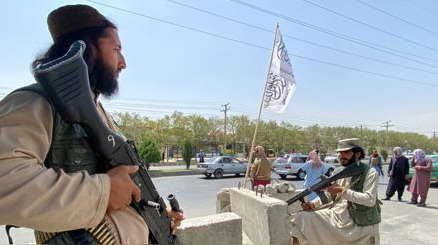
The fall of Afghanistan to the Taliban has raised fears that terrorist groups capable of threatening the U.S. homeland will thrive anew amid the chaos.
U.S. military officials are reassessing their previous estimate that al Qaeda could reconstitute as a threat in two years after the Taliban completed its stunningly rapid rise back to power this weekend.
Since first announcing the U.S. withdrawal from Afghanistan in April, the Biden administration has said it will keep terrorism threats in check using forces based elsewhere in the region.
But the debacle of the withdrawal has raised questions about whether the United States has adequately prepared to face threats emanating from Afghanistan.
“There’s no question that the return of the Taliban opens up space in this new Islamic emirate for al Qaeda to return, rebuild a base, and for other groups associated or previously associated with al Qaeda, like ISIS, to return to the region,” said Jamil Jaffer, founder and executive director of the National Security Institute at George Mason University.
“Jihadi fighters of all stripes will now once again make Afghanistan their home, as they did in the lead-up to 9/11,” added Jaffer, who previously served as senior counsel to Republicans on the House Intelligence Committee.
Those who have argued in favor of staying in Afghanistan throughout the last 20 years have cited the need for a U.S. presence to prevent another 9/11-style attack after the Taliban harbored the perpetrators of those attacks.
But in ordering a withdrawal, Biden held that the United States had accomplished its initial goal of diminishing the threat from al Qaeda, including killing Osama bin Laden a decade ago, and that any future threats could be managed with airstrikes and raids launched from outside Afghanistan as the U.S. military does in several other countries.
“We conduct effective counterterrorism missions against terrorist groups in multiple countries where we don’t have permanent military presence. If necessary, we’ll do the same in Afghanistan,” Biden said in a speech Monday defending his decision to withdraw. “We’ve developed counterterrorism over-the-horizon capability to allow us to keep our eyes firmly fixed on the direct threats to the United States in the region, and act quickly and decisively if needed.”
White House talking points circulated Monday by House Speaker Nancy Pelosi (D-Calif.) to Democratic lawmakers on Monday similarly argued that U.S. forces will “prevent, detect and disrupt terrorism threats from over the horizon,” though in one of the countries it cited as already using over-the-horizon forces, Syria, the United States still has 900 troops in the ground.
The talking points also insisted “that we’ll hold the Taliban accountable to not allowing al Qaeda a safe haven. If they do, there will be consequences that we pursue.”
But the Taliban have flouted their agreement to deny al Qaeda safe haven since they signed a deal with the Trump administration in February 2020, and despite the accord making that a condition of the withdrawal, both former President Trump and Biden proceeded.
As recently as June, the United Nations Security Council reported that “ties between the two groups remain close, based on ideological alignment, relationships forged through common struggle and intermarriage.”
U.S. officials previously warned that while U.S. forces are capable of conducting counterterrorism from a distance, it will be harder, with CIA Director William Burns telling lawmakers in April that “the U.S. government’s ability to collect and act on threats will diminish. That is simply a fact.”
As scenes of chaos emerged from Kabul on Monday while Afghans scrambled to get out, Republicans hammered Biden on the possibility of a terrorist resurgence.
“We’re less safe as a nation,” Sen. Lindsey Graham (R-S.C.) said at a news conference in his home state Monday. “The likelihood of an attack coming from Afghanistan now is through the roof.”
Senate Intelligence Committee Chairman Mark Warner (D-Va.) in a lengthy statement vowing to seek answers on the administration’s lack of preparedness also stressed that “we also cannot lose sight of the reason we were there in the first place and must continue to stay focused on potential threats to the United States posed by terror groups like the Haqqani network, al-Qa‘ida, and ISIS.”
In June, Defense Secretary Lloyd Austin and Chairman of the Joint Chiefs of Staff Gen. Mark Milley told senators they foresaw a “medium” risk that al Qaeda could regain the capability to threaten the United States in “two years.”
Milley also stressed at the time that “if certain other things happen, if there was a collapse of the government or dissolution of the Afghan security forces, that risk would obviously increase.”
With that collapse now a reality, the Pentagon acknowledged Monday it was reassessing the terrorist threat, but held that it is too early for specific predictions.
“I think it’s way too early to make assessments and judgments about what the terrorism threat’s going to be in Afghanistan going forward,” Pentagon press secretary John Kirby told reporters. “The secretary certainly believes that in light of recent events that a reassessment of the possibilities for reconstitution of terrorist networks inside Afghanistan is warranted. But we’re in no position at this point, just one day after the events in Kabul, to make a firm judgment either way what that’s going to look like.”
Experts see a chaotic situation easily exploited by various terror groups.
“The U.S. withdrawal creates a power vacuum that is greater than the Taliban can fill so we are likely to see competition from other regional actors for influence and access to or control over valuable resources,” said Jennifer Cafarella, a national security fellow at the Institute for the Study of War. “We could for example see a renewed ISIS attempt to carve out a stronghold in Afghanistan.”
Retired Col. Christopher Kolenda, who led forces in Afghanistan and later negotiated with the Taliban, sees two likely scenarios: either Afghans work to find some system of government that garners buy-in from its people, or the country descends into civil war and competing fiefdoms.
“That’s where you have the greatest risk for terrorism,” he said. “Afghanistan will be in this civil war and these different fiefdoms will reach out to any groups they can for support and survival.”
Kolenda, however, remains hopeful the U.S. can still play a role in the fallout.
“We can’t control it, but we can influence it,” he said.
The Department of Homeland Security had already upped its warnings about potential attacks from Islamic extremists as the U.S. approaches the anniversary of the 9/11 attacks, saying it “could serve as a catalyst for acts of targeted violence.”
“Al-Qa’ida in the Arabian Peninsula recently released its first English-language copy of Inspire magazine in over four years, which demonstrates that foreign terrorist organizations continue efforts to inspire U.S.-based individuals susceptible to violent extremist influences,” the department wrote in a bulletin on Friday.
But the situation in Afghanistan could exacerbate that.
“The United States had an advantage to prevent another attack on par with 9/11 through a combination of homeland defense measures here in the United States and forward pressure on terrorist groups where they operate,” Cafarella said. “Our withdrawal from Afghanistan removes the most important aspect of that forward pressure.”
Via The Hill


